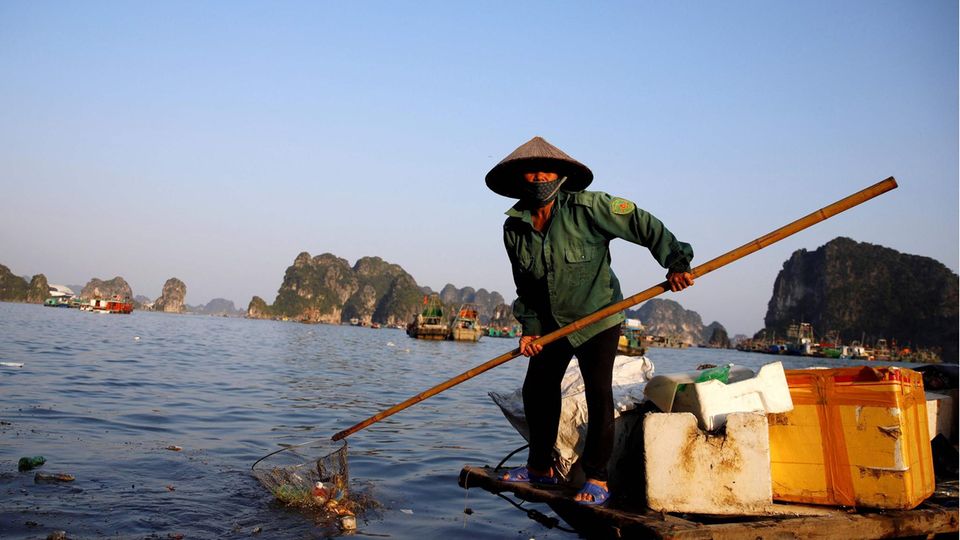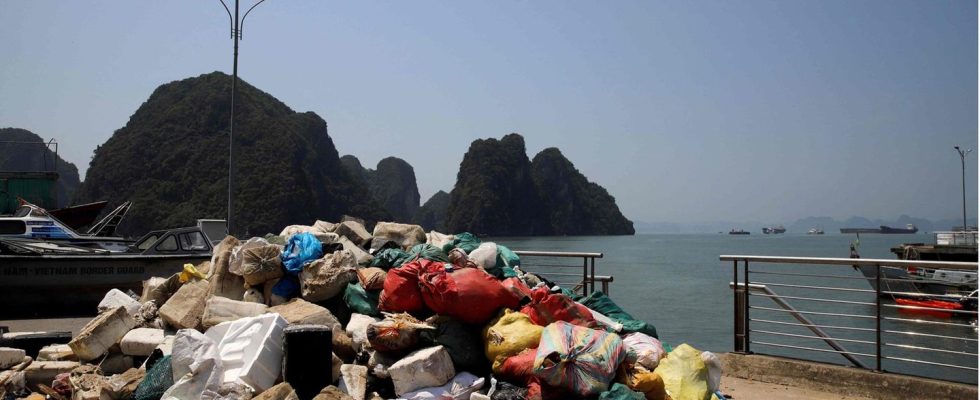Vietnam
Ha Long Bay: From tourist paradise to plastic dump
Since the beginning of March, 10,000 cubic meters of garbage have been collected in Ha Long Bay – about as much as fits in four Olympic-size swimming pools
© Nam NGUYEN / AFP
The “plastic pollution crisis”, as the World Bank calls the excess of garbage in Vietnam, can also be seen in Ha Long Bay. The rapidly growing tourism around the world natural heritage is also to blame for this.
On this hot morning, Vu Thi Thinh perches on the edge of her small boat in Vietnam’s picturesque Ha Long Bay and retrieves a styrofoam packet from the calm water. Around the garbage collector, islands of Styrofoam buoys, plastic bottles and beer cans float through the Unesco World Heritage Site, famous for its turquoise-water beaches and rainforest-covered islands. Because of such plastic waste here and in many other regions of the world, an international agreement will be negotiated in Paris until Friday.
“I’m very tired,” says 50-year-old Thinh, who has worked as a garbage collector for ten years. “Day in and day out – without a break – I pick up garbage from the bay.” According to the Ha Long Bay administration, 10,000 cubic meters of garbage have been collected since the beginning of March – about as much as fits in four Olympic-size swimming pools.
The waste problem has worsened in recent months. Efforts to replace the polystyrene buoys used by fish farms with sustainable models have failed and fishermen simply continue to toss their discarded polystyrene buoys into the water. Authorities deployed 20 barges, eight boats and dozens of people to clean up the bay, state media said. Do Tien Thanh of the relevant authority called the buoys a short-term problem but admitted that Ha Long Bay was “at risk”.
Authorities in Vietnam are again hoping for millions of visitors
Seven million visitors visited the bay’s spectacular limestone formations on Vietnam’s northeast coast in 2022. The authorities are hoping for 8.5 million tourists this year. But the popularity of the area and the rapid growth of Ha Long City have put a heavy strain on the ecosystem. The city now has a cable car, an amusement park, luxury hotels and thousands of new homes. Conservationists estimate that while there used to be 234 species of coral in the bay, there are now half that number.

Sisyphean task: Some garbage collectors have been pulling the garbage out of Ha Long Bay for ten years.
© Nam NGUYEN / AFP
In the past decade, corals had recovered slightly and some dolphins had returned to the bay after fishing was banned in significant parts of the World Heritage Site. But plastic waste and human waste are still a huge problem. According to conservationist Thanh, there are many large residential areas around the bay whose remnants will pollute the ecosystem if not properly cleaned up. “At the moment, the city of Ha Long can only treat about 40 percent of its wastewater in an environmentally friendly manner,” he says.
Tourists complain about the garbage
Disposable bottles are now banned on tourist boats. According to the authorities, the use of single-use plastic has fallen by 90 percent. But the garbage that is produced on land, despite the work of the garbage collectors, mars the beaches. Tourist guide Pham Van Tu says many visitors complain to him. “They read in the media that the bay is beautiful, but when they see the litter in the water, they don’t want to go swimming or canoeing. And they won’t recommend their friends and family to come here.” The German tourist Larissa Helfer is also shocked. “Actually, one should say: ‘Look at the view! Look at the fishing villages!'” she says. But the plastic waste is unmistakable. “And that makes you sad.”
Building for the Guinness Book of Records
Mecca for brave Instagrammers: Vietnam opens the longest glass bridge in the world
Rapid economic growth, urbanization and lifestyle changes in communist Vietnam have led to a “plastic pollution crisis,” according to the World Bank. According to a 2022 report, 3.1 million tons of plastic waste are generated in the country each year. Ten percent of it got into the waterways. This makes Vietnam one of the five main causes of plastic pollution in the oceans. The amount of litter entering the sea could double by 2030, the World Bank warns.
Garbage collector Thinh grew up in Ha Long and remembers a completely different bay. “It didn’t look that terrible,” she says. “Of course all the work makes me tired and angry. But we have to keep going.”


